Jiaming Cheng
Affine Modulation-based Audiogram Fusion Network for Joint Noise Reduction and Hearing Loss Compensation
Sep 09, 2025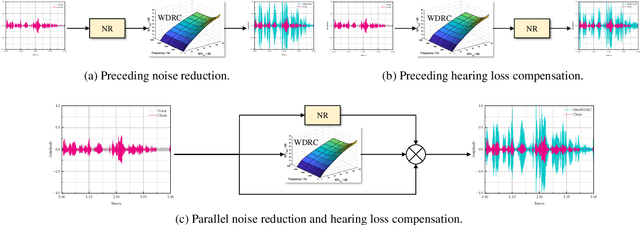
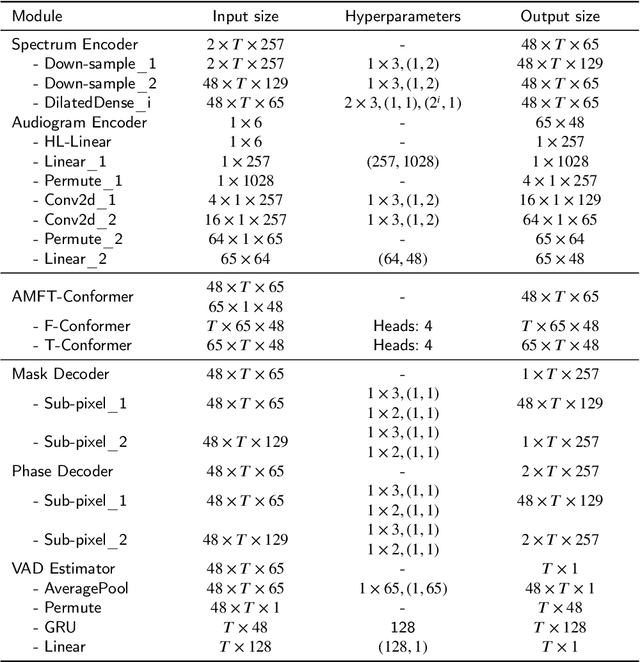
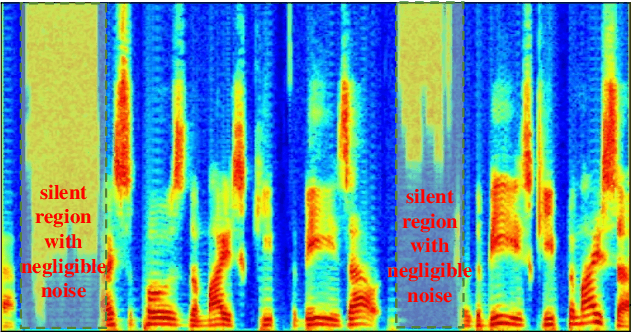

Abstract:Hearing aids (HAs) are widely used to provide personalized speech enhancement (PSE) services, improving the quality of life for individuals with hearing loss. However, HA performance significantly declines in noisy environments as it treats noise reduction (NR) and hearing loss compensation (HLC) as separate tasks. This separation leads to a lack of systematic optimization, overlooking the interactions between these two critical tasks, and increases the system complexity. To address these challenges, we propose a novel audiogram fusion network, named AFN-HearNet, which simultaneously tackles the NR and HLC tasks by fusing cross-domain audiogram and spectrum features. We propose an audiogram-specific encoder that transforms the sparse audiogram profile into a deep representation, addressing the alignment problem of cross-domain features prior to fusion. To incorporate the interactions between NR and HLC tasks, we propose the affine modulation-based audiogram fusion frequency-temporal Conformer that adaptively fuses these two features into a unified deep representation for speech reconstruction. Furthermore, we introduce a voice activity detection auxiliary training task to embed speech and non-speech patterns into the unified deep representation implicitly. We conduct comprehensive experiments across multiple datasets to validate the effectiveness of each proposed module. The results indicate that the AFN-HearNet significantly outperforms state-of-the-art in-context fusion joint models regarding key metrics such as HASQI and PESQ, achieving a considerable trade-off between performance and efficiency. The source code and data will be released at https://github.com/deepnetni/AFN-HearNet.
I$^2$S-TFCKD: Intra-Inter Set Knowledge Distillation with Time-Frequency Calibration for Speech Enhancement
Jun 16, 2025Abstract:In recent years, complexity compression of neural network (NN)-based speech enhancement (SE) models has gradually attracted the attention of researchers, especially in scenarios with limited hardware resources or strict latency requirements. The main difficulties and challenges lie in achieving a balance between complexity and performance according to the characteristics of the task. In this paper, we propose an intra-inter set knowledge distillation (KD) framework with time-frequency calibration (I$^2$S-TFCKD) for SE. Different from previous distillation strategies for SE, the proposed framework fully utilizes the time-frequency differential information of speech while promoting global knowledge flow. Firstly, we propose a multi-layer interactive distillation based on dual-stream time-frequency cross-calibration, which calculates the teacher-student similarity calibration weights in the time and frequency domains respectively and performs cross-weighting, thus enabling refined allocation of distillation contributions across different layers according to speech characteristics. Secondly, we construct a collaborative distillation paradigm for intra-set and inter-set correlations. Within a correlated set, multi-layer teacher-student features are pairwise matched for calibrated distillation. Subsequently, we generate representative features from each correlated set through residual fusion to form the fused feature set that enables inter-set knowledge interaction. The proposed distillation strategy is applied to the dual-path dilated convolutional recurrent network (DPDCRN) that ranked first in the SE track of the L3DAS23 challenge. Objective evaluations demonstrate that the proposed KD strategy consistently and effectively improves the performance of the low-complexity student model and outperforms other distillation schemes.
Deep Learning for CSI Feedback: One-Sided Model and Joint Multi-Module Learning Perspectives
May 09, 2024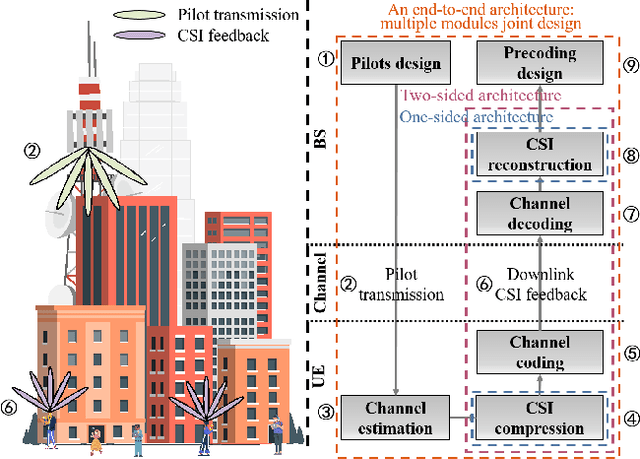

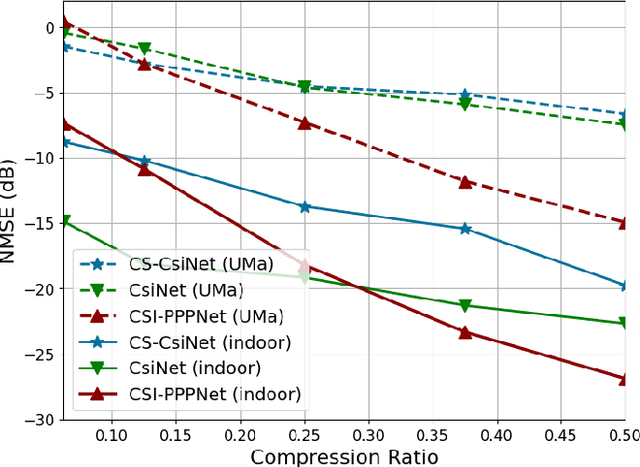
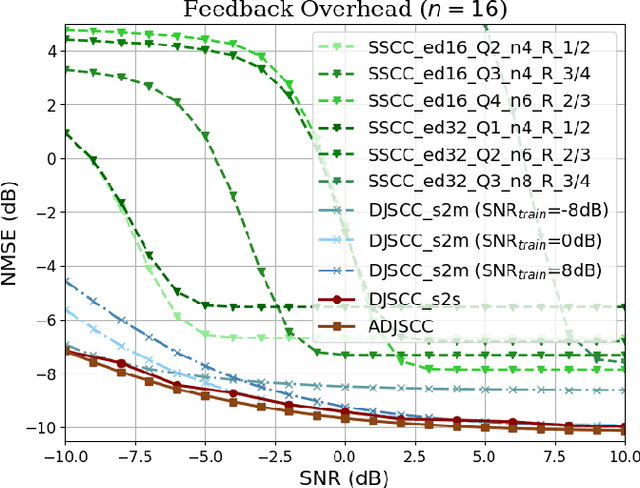
Abstract:The use of deep learning (DL) for channel state information (CSI) feedback has garnered widespread attention across academia and industry. The mainstream DL architectures, e.g., CsiNet, deploy DL models on the base station (BS) side and the user equipment (UE) side, which are highly coupled and need to be trained jointly. However, two-sided DL models require collaborations between different network vendors and UE vendors, which entails considerable challenges in order to achieve consensus, e.g., model maintenance and responsibility. Furthermore, DL-based CSI feedback design invokes DL to reduce only the CSI feedback error, whereas jointly optimizing several modules at the transceivers would provide more significant gains. This article presents DL-based CSI feedback from the perspectives of one-sided model and joint multi-module learning. We herein introduce various novel one-sided CSI feedback architectures. In particular, the recently proposed CSI-PPPNet provides a one-sided one-for-all framework, which allows a DL model to deal with arbitrary CSI compression ratios. We review different joint multi-module learning methods, where the CSI feedback module is learned jointly with other modules including channel coding, channel estimation, pilot design and precoding design. Finally, future directions and challenges for DL-based CSI feedback are discussed, from the perspectives of inherent limitations of artificial intelligence (AI) and practical deployment issues.
Swin Transformer-Based CSI Feedback for Massive MIMO
Jan 12, 2024Abstract:For massive multiple-input multiple-output systems in the frequency division duplex (FDD) mode, accurate downlink channel state information (CSI) is required at the base station (BS). However, the increasing number of transmit antennas aggravates the feedback overhead of CSI. Recently, deep learning (DL) has shown considerable potential to reduce CSI feedback overhead. In this paper, we propose a Swin Transformer-based autoencoder network called SwinCFNet for the CSI feedback task. In particular, the proposed method can effectively capture the long-range dependence information of CSI. Moreover, we explore the impact of the number of Swin Transformer blocks and the dimension of feature channels on the performance of SwinCFNet. Experimental results show that SwinCFNet significantly outperforms other DL-based methods with comparable model sizes, especially for the outdoor scenario.
A Bandit Approach to Online Pricing for Heterogeneous Edge Resource Allocation
Feb 14, 2023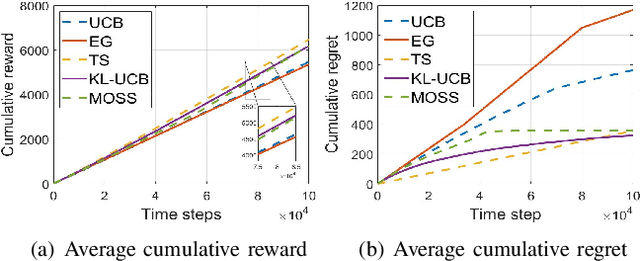
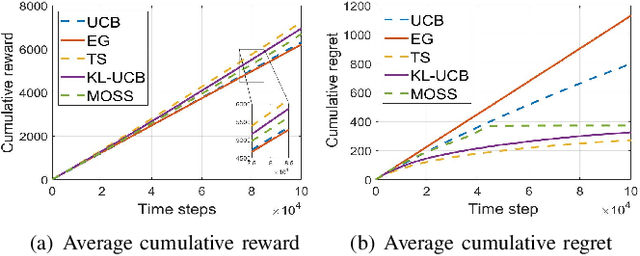
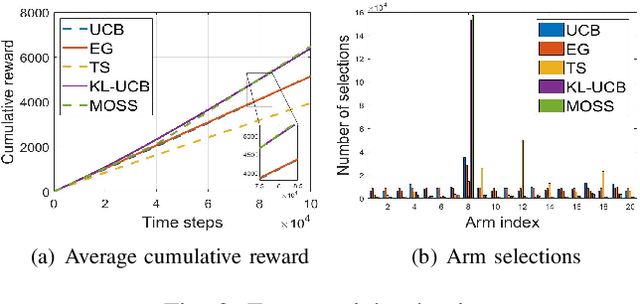

Abstract:Edge Computing (EC) offers a superior user experience by positioning cloud resources in close proximity to end users. The challenge of allocating edge resources efficiently while maximizing profit for the EC platform remains a sophisticated problem, especially with the added complexity of the online arrival of resource requests. To address this challenge, we propose to cast the problem as a multi-armed bandit problem and develop two novel online pricing mechanisms, the Kullback-Leibler Upper Confidence Bound (KL-UCB) algorithm and the Min-Max Optimal algorithm, for heterogeneous edge resource allocation. These mechanisms operate in real-time and do not require prior knowledge of demand distribution, which can be difficult to obtain in practice. The proposed posted pricing schemes allow users to select and pay for their preferred resources, with the platform dynamically adjusting resource prices based on observed historical data. Numerical results show the advantages of the proposed mechanisms compared to several benchmark schemes derived from traditional bandit algorithms, including the Epsilon-Greedy, basic UCB, and Thompson Sampling algorithms.
 Add to Chrome
Add to Chrome Add to Firefox
Add to Firefox Add to Edge
Add to Edge